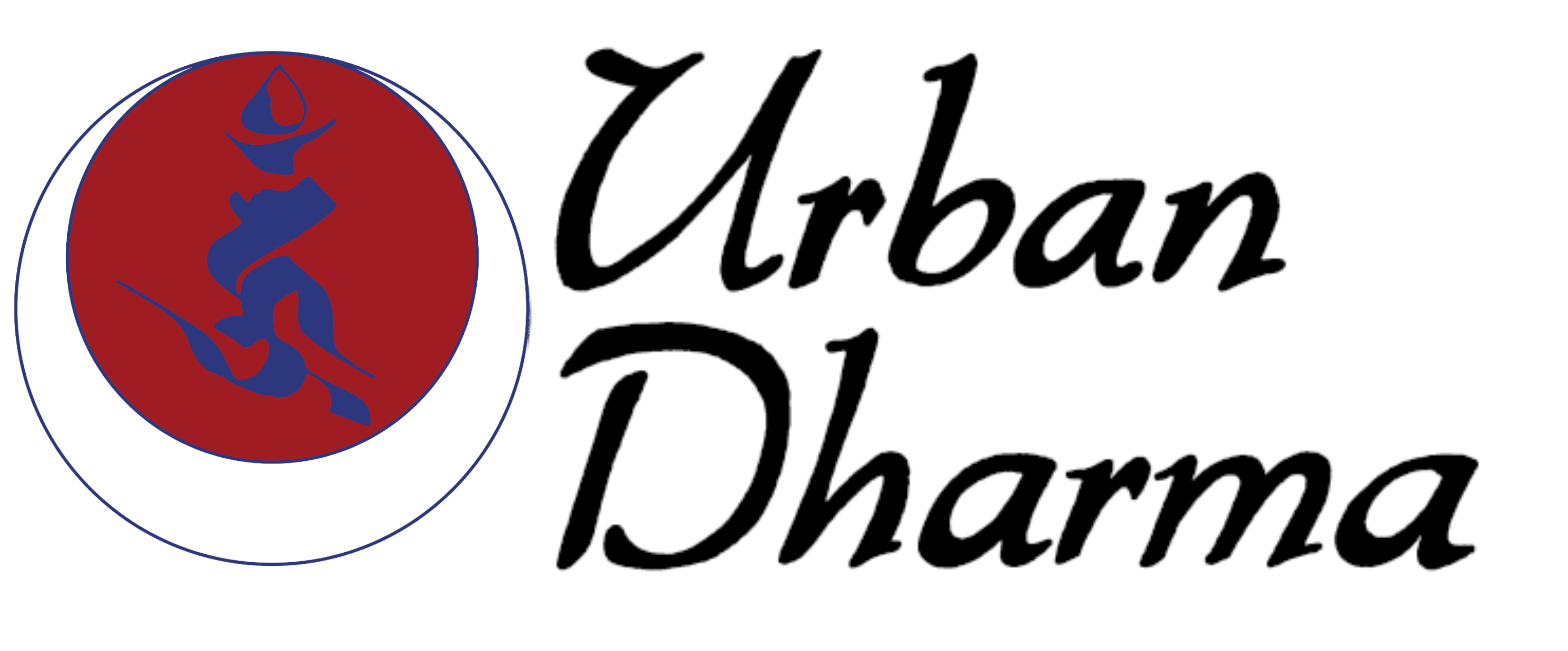Welcome to Asheville’s only downtown Buddhist temple. Aside from our regularly scheduled programs, the community is invited to use this temple as yet another space to experience the sacred, to meditate, or to offer a prayer. As a temple, there are a few etiquette points that we would like to share with you:
Please remove your shoes as you enter the temple space (shoes are encouraged in the gallery area).
Please do not touch the sacred images or the offering objects on the shrines (unless invited to do so).
If a service or program is in progress, please join us – you can pick an open spot to sit on the floor or in the pews. Feel free to leave when you have to.
Service books – Recitations and Liturgies – are available for use during your visit. These books should not be placed on the floor or walked over. They are also available for purchase in the gallery.
Speaking in the temple space with a slightly softer volume is appreciated but there is no need to whisper!
Buddhists often bow or offer prostrations when they first enter a temple. Visitors to our temple are not expected to do so but we are happy to show you how if you so desire.
NAVIGATING OUR TEMPLE SPACE
Main Shrine
At the center is the historical buddha, Śakyamuni who lived in India in the 5th century BCE. This standing, white stone, buddha expresses the vision of Urban Dharma as an active and engaged Buddhist community offering a place for regaining the sacred and the sane in the midst of our busy and active lives. Too often, we are only able to experience the divine when we are out in the mountains or in the woods or in a faraway, idyllic location. At Urban Dharma, we witness to the presence of the sacred and divine right in downtown Asheville, in the hustle and bustle of comings and going.
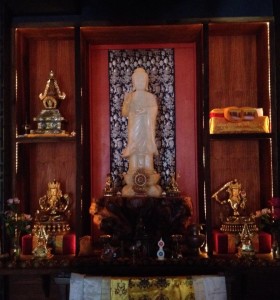
To Śakyamuni’s top right[1], is a stūpa; stūpas were originally Indian reliquaries for interring the remains of important people who have died. When the buddha passed away, his ashes were placed in eight stūpas. Eventually, stūpas have come to represent the enlightened mind just as buddha images represent the enlightened body of all buddhas. To the buddha’s top left corner, are volumes of Buddhist scriptures. These scriptures contain the Dharma (teachings of the Buddha) that shows the way to liberation from confusion and suffering. Here, these scriptures represent the enlightened speech of all buddhas.
Together, these representations of enlightened body, speech and mind remind Buddhists of the potential that we all have in transforming the entirety our confused existence (in its physical, verbal and mental/emotional dimensions) into the state of enlightened body, speech and mind. Thus, when understood this way, we can relate to the sacred forms enshrined here as skillful devices for the transformation of suffering and confusion rather than as idolatrous images or objects of art.
The smaller representations in front of Śakyamuni, to the right, are Jikten Sumgön, forefather of Drikung Kagyü lineage (12th century), a carved Dharma Wheel, and Padmasambhava who established Buddhism in Tibet in the 8th century. With the main buddha statue representing the Buddha Jewel, the Dharma Wheel in turn represents the Dharma Jewel and Jikten Sumgön and Padmasambhava represent the Sangha Jewel. Collectively, these are the Three Jewels to whom Buddhists go to as sources of refuge or protection from confusion and suffering. Finally, the Medicine Buddha statue immediately below the Dharma Wheel shows the buddha as the Supreme Healer, offering relief from the myriad sufferings that manifest from the three poisons of ignorance, attachment, and aversion.
To the left and right of the main panel: Below the stūpa, is Avalokiteśvara, the embodiment of compassion, and below the scriptures, is Mañjuśrī, the embodiment of wisdom. Enlightenment in Buddhism is understood as the perfection of wisdom and compassion, often referred to as the “two wings of Enlightenment.”
Activity
Traditionally, Tibetans offer kataks (ritual scarves) at the main shrine. We have kataks available for purchase ($2) on the front counter by the tea area. Kataks can be placed on the stand in front of the shrine. Kataks represent devotion, sincerity and respect. Before you leave, you are welcome to take a different katak from the stand as a blessing and keepsake.
Other Shrines
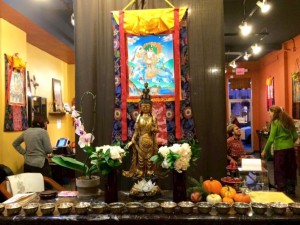
The secondary shrine immediately across from the main is dedicated to all protectors of the Dharma (teachings of the Buddha). The thangka (painted scroll) depicts Achi Chökyi Drolma, the great-grandmother of Jikten Sumgon (forefather of Drikung Kagyü lineage). Thus, great-grandmother Achi serves as a special protector to the Dharma as propagated by the lineage that we are most closely associated with. The statue enshrined here is the eleven-headed Guanyin, the Chinese form of Avalokiteśvara depicted here in artistic style of the Tang Dynasty (618-907). The multiplicity of heads represents the omnipresence of compassionate guidance.
Activity
Here, you can consult the Guanyin oracle. Devotees seek guidance from Guanyin, from mundane day-to-day concerns to profound spiritual quandaries: Some consult regarding career choices, life direction and love, others seek guidance for health issues, unresolved conflicts and spiritual insight. There are 100 poems in this oracle set, each represented by a bamboo stick (marked with a number). These poems can be found in the “Kuan Yin Temple Oracle” book (pp. 32-81). You receive the answer to your question by pulling out a red bamboo stick after presenting your question to Guanyin. For directions on how to use the fortune sticks and moon disks to consult the oracle, refer to pp. 25-27 of the “Kuan Yin Temple Oracle.”
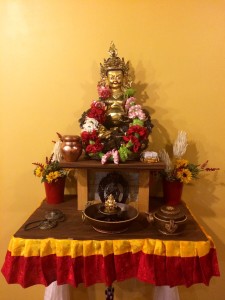
The side shrine above the pews is dedicated to Jambhala, the embodiment of abundance and richness. Those who pray to Jambhala will be free from miserliness, poverty-mind and lack. You are invited to make a water-offering by picking up the pot on the right and pouring the offering over the head of the small Jambhala statue seated in the basin. As you pour the water, think of it as a cooling shower that pleases Jambhala and the water that overflows becomes the water that quenches the existential thirst of all beings.
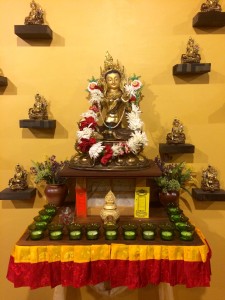
Finally, on the last side shrine is Tārā, the “Mother of all Buddhas.” The main Tārā is surrounded by smaller images of the twenty-one manifestations of Tārā. Buddhists invoke Tārā for protection from all fears and terrors. Tārā offers the swiftest assistance to sincere devotees. She is therefore, much loved and revered. Offer a prayer to her by lighting a votive candle and spending some moments of quiet reflection.
[1] Out of respect, when speaking of the position of deity-images on shrines, Buddhists take the perspective of the deities. Thus, “right” is “stage right” and “left” is “stage left.”
Coming Soon!
This page is currently under construction. Check back soon for updates!
